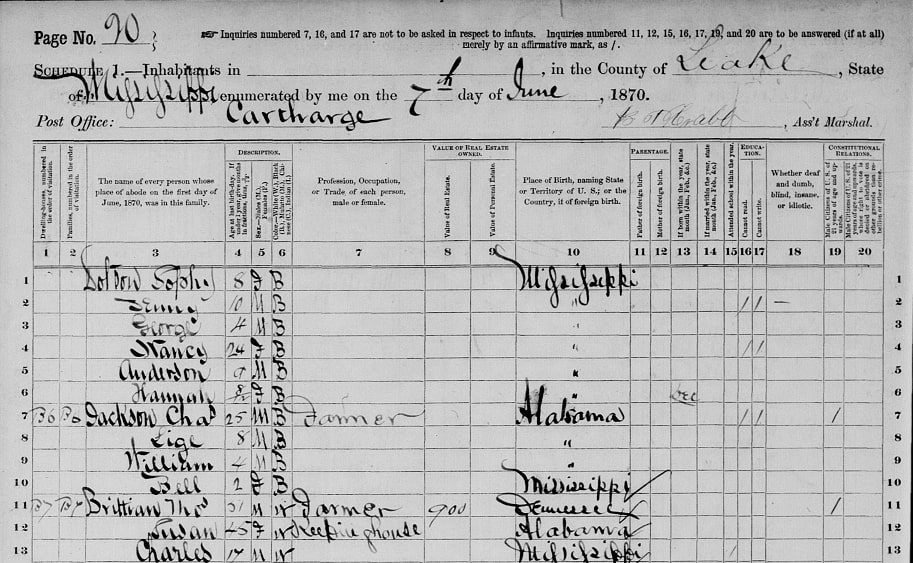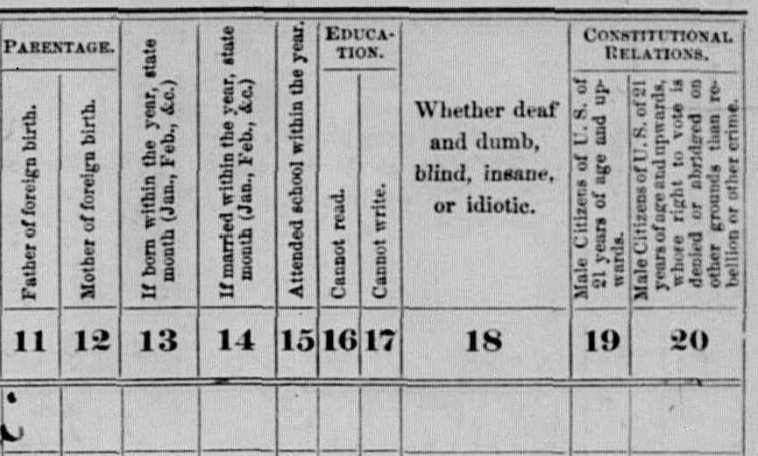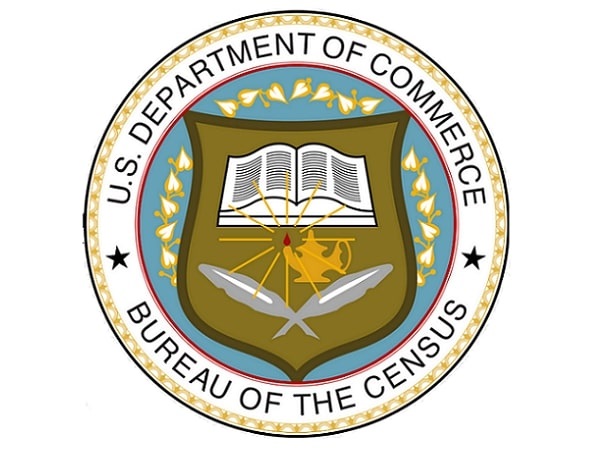Introduction: In this article, Gena Philibert-Ortega describes some unique aspects of the 1870 Census – the first federal census after slavery was abolished in the U.S. Gena is a genealogist and author of the book “From the Family Kitchen.”
Searching the 1870 U.S. Federal Census is an essential step for those researching the formerly enslaved. It is the first census that the formerly enslaved are listed by name, and with the additional information gathered about every person, we get a snapshot of their life in a specific location after the U.S. Civil War.

As we think about African American men after the Civil War, it’s vital that we consider the rights they received and what records might exist because of those rights. While it’s easy for us to quickly look at a census enumeration for names, ages, and location, don’t forget to carefully study the entire census entry. An important part of the census enumeration often overlooked is found in the last two columns: the “Constitutional Relations” questions.
The 1870 Census and the 15th Amendment
The last two questions on the 1870 population schedule appear under the heading “Constitutional Relations.”

These two questions refer to voting rights and, more specifically for African American men, the 14th and 15th Amendments to the Constitution. The 14th Amendment defines citizenship, including African Americans as U.S. citizens. The 15th Amendment reads:
“The right of citizens of the United States to vote shall not be denied or abridged by the United States or by any State on account of race, color, or previous condition of servitude.”
The 1870 Census asks two questions related to citizenship rights. (1)
Question 19 asks:
“Is the person a male citizen of the United States of 21 years or upwards?”
This question helps enumerators ascertain if the person would have the right to vote. Now this doesn’t mean they exercised the right or could exercise their right.
The next question, Question 20, follows-up with:
“Is the person a male citizen of the United States of 21 years or upwards whose right to vote is denied or abridged on grounds other than ‘rebellion or other crime’?”
These two questions have to do with men, ages 21 years and older, who could vote. This would include the formerly enslaved. Who couldn’t vote in 1870?
Women didn’t have the federal right to vote. Native Americans wouldn’t be considered U.S. citizens until the 1920s, so they didn’t have the right to vote. (2) And some white men did not have the right to vote in 1870, specifically those who sided with the Confederate states. During Reconstruction, Confederate states had to be readmitted to the Union, after writing a new state constitution and ratifying the 15th Amendment. Men loyal to the Confederacy and high-ranking officials lost their right to vote, and that wouldn’t be restored for some until the Amnesty Act of 1872. So, some men over the age of 21 were not able to vote because of “rebellion or other crime.”
The 15th Amendment granted voting rights to African American men. However, much stood in the way of the formerly enslaved and their ability to exercise that right. Literacy tests, poll taxes, and intimidation or violence meant that not everyone who could vote, did. If it was filled out, Column 20 provided insight into those obstacles.
Enumerating the 1870 Census
Unfortunately, although the 1870 Census attempted to shine a light on suffrage rights, it had problems with the execution of the enumeration:
“…The 1870 Census suffered from extremely poor field procedures and some badly worded questions. It was plagued with undercounts, local demands for recounts, and inadequate responses to questions.” (3)
White Southerners were reluctant to answer questions by the federal government, the West was difficult to enumerate because of its unsettled vastness, and Eastern cities were “exploding from migrants, both native-born and foreign-born.” (4) It’s possible that the last question was a hard one to answer for those who had previously been unable to vote.
Familiarity with enumerator instructions help us learn more about what enumerators were told in regards to collecting information. In this case, the instructions encourage the enumerators to learn about their state voting laws. And the instructions acknowledge that getting this information was a “matter of delicacy.”
Two last things to consider when analyzing your ancestor in the 1870 U.S. Census. First, we don’t know who the informant was for the information found on the census. It could be a family member, but it also could be a neighbor. Obviously, for this reason the information may be less than correct.
Second, race was to be indicated by “‘W’ for White, ‘B’ for Black, ‘M’ for Mulatto, ‘C’ for Chinese [a category which included all east Asians], or ‘I’ for American Indian.” (5) Mulatto was the racial designation to be used for a mixed-race person with any amount of “African blood.” However, there’s no way to know if the person being enumerated provided that information or if the enumerator based the answer on an assumption based on what the person looked like.
What Does the 1870 Census Say about Your Ancestor?
Census records are an important addition to our research. However, make sure to fully study the questions asked and the information your ancestor gave. Don’t stop at just looking at the census records. Take time to read the enumerator instructions, and look into a collection of historical newspapers, such as GenealogyBank’s Historical Newspaper Archives, for clues about what our ancestors knew about the census and any statistical reports from the enumeration.
_________________
(1) This question does not relate to women because they did not have the right to vote. Even for men, voting rights are a more complex topic – and so when researching, make sure to look up who had the right to vote in the locality you are researching.
(2) “Indian Citizenship Act,” Library of Congress (https://www.loc.gov/item/today-in-history/june-02/#:~:text=On%20June%202%2C%201924%2C%20Congress,barred%20Native%20Americans%20from%20voting.: accessed 18 February 2022).
(3) Andersen, Margo J. The American Census: A Social History (New Haven: Yale University Press, 1988), p. 78.
(4) Ibid.
(5) “1870,” United States Census Bureau (https://www.census.gov/history/www/through_the_decades/index_of_questions/1870_1.html: accessed 18 February 2022).
Related Articles:
